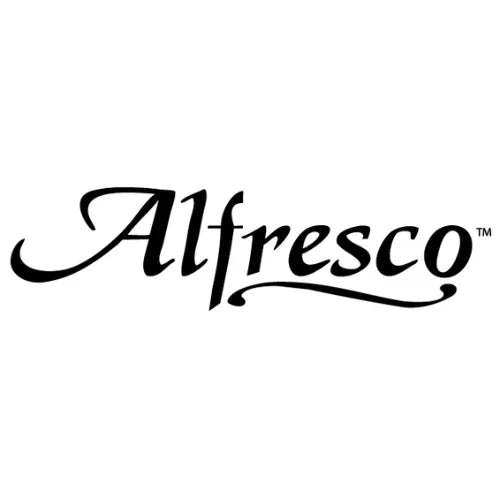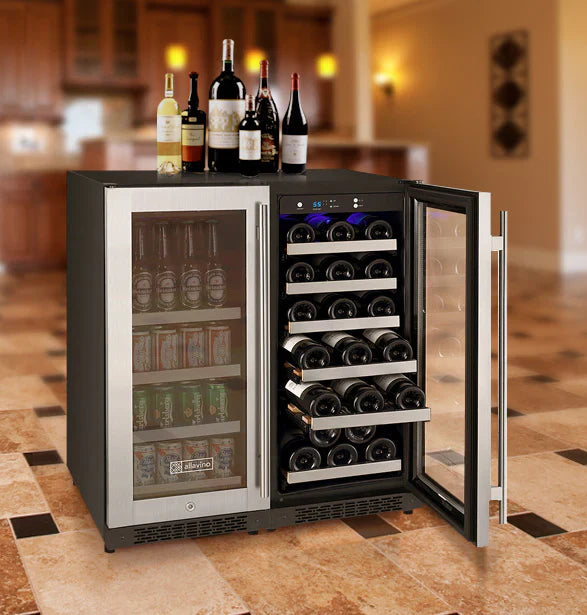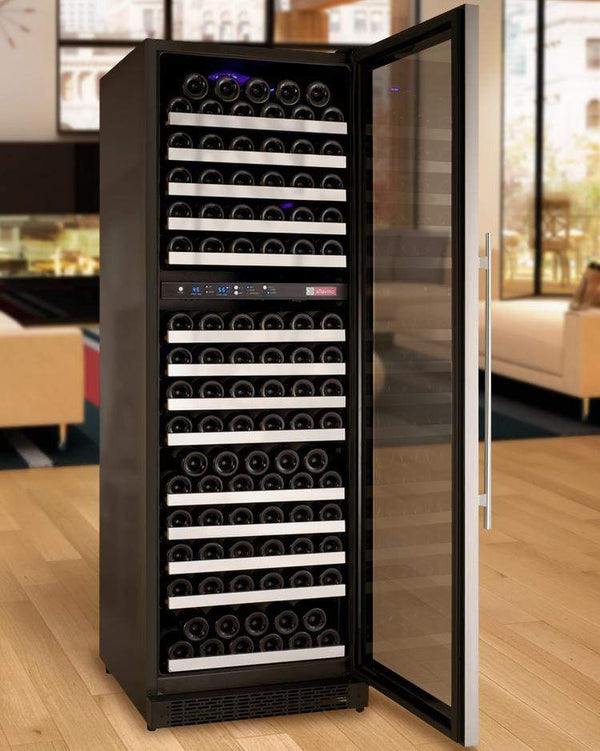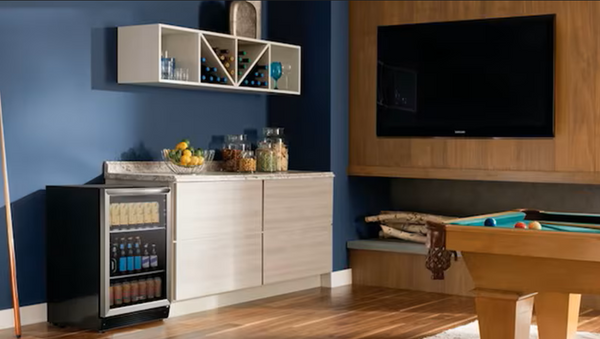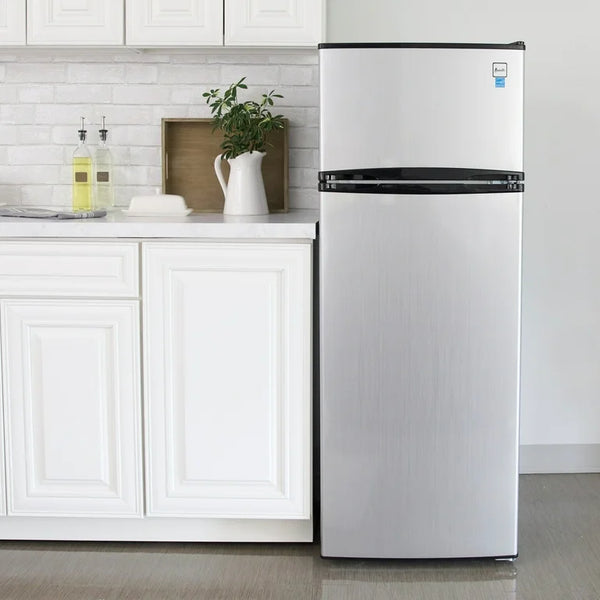Designing a Wine Cellar?
Let’s get it right.
Our specialists review your room layout, insulation, and heat load to recommend the correct cooling system for stable temperature and reliable climate control.
How to Build a Wine Cellar: Step-by-Step Guide
Build Your Dream Wine Cellar: A Step-by-Step Guide for Beginners
By Jim Hopper, Wine Cooling Expert
You probably have dreamed of having a Wine Cellar. I mean, who wouldn’t want to store their finest wines in the optimal location? But imagine all the time and energy it would take to search for the right one. This is why we created this step-by-step guide on How to Build a Wine Cellar to save you time, effort, and maybe even some money by helping you build your own wine cellar. Creating the ideal environment for your wine collection is key to preserving its quality and flavor.
If you need personalized support or inspiration for your project, check out our Wine Cellar Design resources.
Click on the links provided for more detailed information. Explore the various sections of the guide to fully understand the process of building a wine cellar.
For an in-depth overview of the entire process, check out our Guide for Building Your Own Wine Cellar.
Pre-Step: Is a Building Permit Required?
You might need to get a permit before you start building your wine cellar. Although not all projects require a permit, it’s a good idea to double-check with your local building office to make sure your cellar construction complies with local, state, and national building rules.
Having your own wine cellar allows you to create a personalized wine storage space, ensuring your collection is stored under optimal conditions and tailored to your unique needs and preferences.
Planning and Preparation
Assessing Your Space
When planning a wine cellar, it’s essential to assess the space where you intend to build it. Consider the size of the room, the location, and the surrounding environment. A basement is often an ideal location for a wine cellar due to its natural coolness and humidity. However, if you don’t have a basement, you can still create a wine cellar in a spare room or even a closet. The key is to find a space that can be easily controlled in terms of temperature and humidity, and that is free from vibrations and direct sunlight. This will help ensure that your wine collection is stored in optimal conditions.
If you’re considering a basement build, don’t miss our detailed tips in How to Build Basement Wine Cellar.
Wine Storage Requirements
Before building a wine cellar, it’s crucial to determine your wine storage requirements. Consider the number of wine bottles you plan to store, the type of wine, and the desired temperature and humidity levels.Wine thrives in a consistent environment with temperatures between 50 and 60 degrees Fahrenheit. A general rule of thumb is to plan for at least 25% more space than your current collection requires. This allows room for your collection to grow and ensures that you won’t run out of space too quickly. Additionally, different types of wine may have slightly different storage needs, so it’s important to plan accordingly to maintain the quality and longevity of your wines. Invest in a hygrometer to monitor humidity levels and adjust as necessary to maintain optimal levels.
Need help organizing your collection? See our Guide to Wine Storage for expert tips on maximizing space and maintaining bottle quality.
DIY Wine Cellar Considerations
Building a DIY wine cellar can be a rewarding project, but it requires careful consideration of several factors. These include the type of insulation, the cooling unit, and the vapor barrier. It’s essential to choose materials that can withstand the humid environment of a wine cellar, such as closed cell foam insulation and exterior-grade doors. Closed cell foam insulation is particularly effective because it provides excellent thermal resistance and helps prevent moisture buildup. Additionally, selecting the right cooling unit is crucial to maintaining the ideal temperature and humidity levels for your wine collection. A well-planned DIY wine cellar can provide a perfect environment for your wines and add value to your home.
Wine Cellar Location
The location you choose can have an impact on the expense of maintaining your wine cellar or wine storage in the future.
“Can I put a wine cellar at home?” – this is the most frequently asked question we often get. Our answer: Yes. If you’re planning to build one, wine cellars should be kept cool and dry with no natural light, no vibrations, no unpleasant odors, and a consistent temperature.
Choosing the right location for your own wine cellar is crucial to ensure optimal conditions for wine storage.

Finding a good wine cellar location can help you figure out how to size a wine cellar cooling unit and how to determine the size of wine cellar cooling unit. In order to maintain the right conditions, you will need to purchase a larger, modern wine room cooler if the surrounding environment has an average yearly temperature of 85° compared to a temperature of 65°. Also, a dry environment will require more frequent humidification.
A small wine cellar cooling unit and the lower the overall cost, the closer you go to the 55°F–58°F temperature and 55%–75% percent humidity that your wine requires.
It’s much easier to control these factors if you start in the right place, which is why a wine cellar basement is often recommended, as it’s much cooler and more humid than the rest of your house (usually around 70% in the basement vs 30% in your house), and it’s usually free of other issues like odors, vibrations, and natural light.
These are the most popular locations for a wine cellar:
- Basement
- Closet Wine Cellar
- Dining room
- Living room
- Guest room
- Under the stairs
- Hallway
Still deciding on the right spot? Explore the Best Places to Put a Wine Cellar in Your Home.
Budgeting and Cost Considerations
Building a wine cellar is a rewarding investment, but careful budgeting is essential to avoid surprises and ensure your project aligns with your goals. Costs can vary widely based on cellar size, materials, equipment, and whether you choose a DIY approach or hire professionals.
Typical Cost Ranges
The total cost of a wine cellar can range from as little as $250 for a basic DIY setup to $40,000 or more for a larger, professionally finished cellar. Most home wine cellars fall somewhere in between.
-
DIY Basic Cellar: $250–$2,000
Stackable racks, basic insulation, and minimal finishing. Suitable for small spaces or starter collections. -
Mid-Range Cellar: $2,000–$15,000
Upgraded cooling, better insulation, custom racks, and improved finishes. May involve some professional help. -
Luxury/Professional Cellar: $15,000–$100,000+
High-end finishes, climate control, custom carpentry, and professional installation throughout.
DIY vs. Professional Installation
-
DIY:
Pros: Lower cost, personal satisfaction, control over design.
Cons: Time-consuming, requires tools and skills, mistakes can be costly if insulation or cooling is not installed properly. -
Professional:
Pros: Expertise ensures correct installation and long-term reliability, faster completion.
Cons: Higher upfront cost, less flexibility for personal touches.
Itemized Budget Considerations
When planning your budget, consider these main expenses:
-
Insulation and Vapor Barrier:
$100–$2,000+ (depends on cellar size and insulation type) -
Framing and Construction Materials:
$200–$2,000 -
Floor Sealing:
$50–$500 -
Cooling System:
$250–$10,000+ (basic units to advanced systems) -
Wine Racks:
$100–$10,000+ (kit racks vs. custom) -
Doors:
$200–$3,000 (exterior-grade or specialty wine cellar doors) -
Labor (if hiring professionals):
Varies widely; request quotes for accurate estimates.
Where to Save and Where to Invest
-
Invest in:
Insulation, vapor barrier, and a reliable cooling system—these protect your wine and ensure cellar longevity. -
Save on:
Racking (kit racks are cheaper), finishes, and DIY labor if you have the skills.
Factors That Affect Your Budget
- Cellar Size and Capacity: Larger cellars require more materials and higher-capacity equipment.
- Location: Basements often need less cooling but may require more waterproofing.
- Material Choices: Premium woods, tile, or glass features increase costs.
- Desired Features: Extras like custom lighting, tasting areas, or display racks add to the total.
Check for Leaks

The goal is to build a wine cellar that is properly sealed. Check the room for air leaks and make sure there are no surprises lurking in the walls that might threaten your wine collection. You need to prepare the room in such a way that you can control all environmental factors that may affect the proper aging of wine. This room will now be the center of your obsession, and the home of your wine collection and you do not want it to damage all your wines simply because you did not properly check the area for air leaks, light leaks, or water leaks. When building your own wine cellar, it is crucial to ensure there are no leaks that could compromise the environment.
The goal here is to create a tightly sealed space. Thoroughly inspect for air, light, or water leaks, and make sure there isn’t anything hidden in the walls that could jeopardize your wine collection. You must set up the area in such a way that you can regulate all environmental conditions that could affect wine aging.
When inspecting the space, make sure the ceiling has at least R-19 insulation and the floor is sealed and made of concrete.
Framing Walls and Ceiling
Installing Studs
In framing a wine cellar, you will need to stud the space first. And prior to putting up studs, you also need to seal the concrete foundation walls.
Note: If you're going to use a 6 mil vapor barrier for new construction, check out step #4 and do that step during studding. If you're going to use spray foam, keep going with this step as is.
We recommend using either 2x4 or 2x6 framing application for your wine cellar walls.
If you wish to boost the insulating value while reducing wine cooler unit size and energy consumption, the 2x6 construction is a better option. This is similar to insulating your home to reduce your monthly utility expenditures. When building your home wine cellar, you should get a permit and follow all local, state, and national building codes.
Soffits
If you're going to build a soffit to hide the ductwork, pipes, or other obstructions, make sure the lighting in the soffit is far enough away from the finish racking or ducting depth, including the crown molding depth. At this point, you should know about the final depth of your racking, crown molding, and size of the ring of your wine cellar’s light fixture.
As a rule of thumb, a 1-inch gap should be left between the front of the crown molding and the edge of your lighting. You can also use IC can lights to insulate the area surrounding them.
For Ducted Wine Cellar Cooling System Installations

When installing a ducted wine cellar cooling system, it’s essential to consider the size of the space and the desired temperature and humidity levels. A ducted system is ideal for larger spaces and can provide more efficient cooling. However, it requires more complex installation and may require professional assistance. These systems are designed to distribute cool air evenly throughout the wine cellar, ensuring that all areas maintain the desired conditions. If you have a large wine collection or a spacious wine cellar, a ducted cooling system can be a great investment to protect your wines
Check out our Ducted Wine Cellar Cooling Systems:
For Ductless Split Wine Room Cooling Unit Installations

A ductless split wine room cooling unit is a popular choice for smaller spaces or for those who want a more straightforward installation process. These units are compact, energy-efficient, and can provide precise temperature control. However, they may not be suitable for larger spaces or for those who require more complex cooling systems. Ductless split systems are easy to install and maintain, making them an excellent option for DIY enthusiasts. They offer flexibility in placement and can be a cost-effective solution for maintaining the perfect environment for your wine collection.
By carefully assessing your space, determining your wine storage requirements, and considering the type of cooling system and insulation, you can create a functional and aesthetically pleasing wine cellar that meets your needs and protects your valuable wine collection.
Check out our Ductless Split Wine Room Cooling Units
For Self-Contained Wine Storage Coolers Installations

If you want to use a Self-Contained Cooling Unit, you'll need to install an opening in the wall just enough to fit the cooling unit. You'll also need to install an electrical outlet near the cellar, which could be on the inside or outside of the wine cooling unit, depending on the model you choose.
Since most of these wall mounted wine coolers require a drain line, you'll need to make room for a condensate drain. Some of these units cannot deliver wine cellar humidity, so a 110V electrical outlet is required in the wine cellar for a humidifier.
Check out our Self-Contained Wine Cellar Coolers:
- Self-Contained Fully Ducted Wine Cooling Units
- Self-Contained Through-the-Wall Wine Cooling Units
- Wine Cabinet Coolers / Cabinet Wine Cooling Units
Who makes the best wine cellar cooling unit?
WhisperKOOL, Breezaire, Wine Guardian and CellarCool are some of the brands who make the best wine cellar cooler units.
You can see our whole selection of wine cooling systems, ranging from mini wine cellar air conditioners to large modern wine cellar refrigeration units, commercial and residential wine cellar coolers, and other wine cellar refrigeration needs: Wine Cellar Cooling Units
What is the best wine cellar cooling unit?
Check out our article about the 10 Best Wine Cellar Cooling Units.
How to explore and choose a wine cellar cooling unit?
When choosing a wine cellar cooling system, you must ensure that it suits your wine cellar. To make sure that you'll get the right unit, reach out to experts on the Contact us page.
Insulation and Vapor Barrier


Choosing Your Insulation & Vapor Barrier
Wine cellar insulation and vapor barriers are the most commonly used methods. These are fiberglass batts and spray foam or a 6 millimeter vapor barrier.
A 6 mm vapor barrier is not required when using spray foam. However, spray foams are usually more expensive, but the advantage is that they can help avoid a vapor barrier rupture produced by inserting screws, piping, running cable, or other materials into or through the wall from outside the wine cellar. The screw doesn’t damage the enclosure when using a non-shrinking closed cell spray foam, and the foam will expand to cover and tightly seal all crevices. For both methods, be sure there are no air gaps between the insulation and the drywall.
The same requirements and instructions should also be followed for building small home wine cellars such as a modern wine closet, walk in wine cellar, and wine cellar cabinet.
Insulation & Vapor Barrier for New Construction
If you're doing new construction and won't be using spray foam, installing a 6 mm vapor barrier at the back of the wall studs is a good idea. If your ceiling joists and floor aren't on a slab, you'll also need to cover them.
Note: There are areas where the local code mandates that all vapor barriers be constructed on the cellar’s warm side. We strongly advise you to use spray foam insulation in certain areas.
For a comparison of insulation options and guidance on what’s best for your cellar, visit Best Wine Cellar Insulation Options.
Insulation & Vapor Barrier for Remodeling
If you’re doing a remodeling project for your wine cellar, wrapping the existing studs in the room in the same manner as the ceiling joists is the ideal thing to do. Check that the vapor barrier is on the exterior wall or the warm side of the wine cellar. Sealing and insulating the floor is necessary to maintain a controlled environment.
Fill the stud and joist voids with insulation once the vapor barrier has been installed. The most common type of insulation is fiberglass batts. Fiberglass has an R-13 insulation value in a 2x4 wall cavity, while a 2x6 wall fiberglass has an R-19 insulation value. Insulation must be fluffed so no voids and gaps can form
Filling Holes and Wrapping Walls
Leave enough vapor barrier at the corners to wrap it around, overlap the seams, and tuck them tightly with tuck tape (not duct tape). To reduce air movement, plug all holes in studs and joists with fire-rated penetration sealant.
Important notes: Keeping your wine cellar warm
- A closed cell foam insulation is more resistant to air, vapor, and water on the walls of your wine cellar. To avoid moisture leaks in your cellar, you must add insulation and a vapor barrier.
- Closed cell foam insulation is the best wine cellar insulation for those who live in humid areas because you don’t need an additional vapor barrier, it controls wine storage humidity well, and prevents minor punctures caused by screwing.
- Rigid foam board insulation and fiberglass batt insulation are alternatives to closed cell spray foam.
- When it comes to insulation, choose R-19 for the walls and R-30 for the ceiling. The higher the R-value, the better the insulation.
-
Access to plumbed water is necessary if you plan to include a sink or wet bar.
Seal the Concrete Floor

The best material for flooring is concrete. Anything other than concrete such as wood and rugs should be avoided in wine storage areas. They’re far too leaky and porous. Even concrete can be surprisingly permeable, which is why it needs to be sealed. Sealing the concrete floor is a crucial step in building your own wine cellar.
Allow the concrete to fully cure for 28 days. After the concrete has fully set, apply penetrating sealers (silanes and siloxanes) or high-performance coatings (epoxies and urethane) to seal the floor.
If you’re going to apply a sealant to a tiled floor, make sure the sealant is compatible with the tile’s adhesive.
Electrical Outlet Placement
If you’re building a wine cellar, outlets should be placed in the empty spaces at the corners where your racks join together. Make sure it is not blocked by one of the wine rack posts. Also, it’s important to follow your local building code when placing outlets in your wine cellar, since this will overrule any recommendations offered. Proper electrical outlet placement is crucial for the functionality and safety of your own wine cellar.
There is no need to put an electrical outlet in the high reveal racking area to plug in your lighting. The cord will be able to reach the dead area in the outlet. If you want an outlet in this location for convenience, inform your design consultant so they can locate the outlets correctly for you. High reveals and other accent lighting such as archway lighting, should be connected to a switch.
Wall Coverings

The next step is to cover the walls and ceiling once the studs, vapor barrier, insulation, and electrical outlets have been placed. You will need to use materials that are resistant to the high humidity levels in your cellar.
The most common choice for wall and ceiling coverings is a water resistant Drywall, also known as the Green Board Drywall, which is resistant to extreme humidity conditions. This is the same drywall that is used in most homes, bathrooms, and kitchens, therefore it is easily available.
The water resistant drywall should be screwed into the walls and ceiling of your DIY wine cellar. Seal all penetrations on both sides of the wine cellar using fire-rated puncture sealants. Choosing the right wall coverings is crucial for the aesthetics and functionality of your own wine cellar.
Drywall Finishing
The drywall must be installed all the way to the floor with no gaps. The base molding must be connected to the front of the racking. In addition, no molding should be put to the wall to keep the back of the rack flush with it.
Drywall Painting
When painting drywall, start by priming the drywall and then painting it with a water-based exterior grade paint. Try to let the room air out because oil or solvent-based paints may leave a persistent odor in your wine cellar. Ensure that you or your painter goes all the way to the floor when painting the drywall. They usually end about an inch or two short of the floor since base molding will cover it. Chemical materials like paints or sealants with VOCs should be avoided due to their potential impact on wine flavor.
Alternative Wall & Ceiling Coverings
A decorative option to cover your walls and ceiling would be to apply tongue and groove material that complements the wood, stain, and/or lacquer that will be on your racking. You will first need to screw ¾” marine-grade plywood on your walls and ceiling so that you will be able to attach your tongue and groove.
Apply tongue and groove material that matches the wood, stain, and/or lacquer that will be on your racking as a decorative alternative for covering your walls and ceiling. To install your tongue and groove, you must first screw ¾” marine-grade plywood to your walls and ceiling.
Your wall finish should mirror the look you want for your wine cellar while also being humidity resistant. Humidity is equally important, with ideal levels ranging from 50% to 70%. Humidity is important to keep corks from drying out and shrinking, which could lead to oxidation of the wine.
Following the drywall installation, you can finish the walls with whatever you like to create your desired look, whether you like:
- Faux rock
- Real rock
- Brick
- Tile
- Stucco
- Wood
The aesthetic of a wine cellar should reflect the personality of the owner while being functional.
Lighting

When it comes to lighting options for a home wine cellar, there are a few limitations. If you plan to use can lighting in a wine cellar, you must use thermally fused can lights, commonly known as IC-rated cans.
Concerns have also been raised about the harmful influence of UV lamps on long-term storage. Although there is currently no scientific evidence to support either side, some industry experts advise you to avoid UV lighting.
But what about UV-C light bulbs in wine cellar cooling units? That’s a different story. To ensure that the air within your wine cellar is clean and that your wine cooling system is operating at its best, you might want to read more about UV-C technology.
Proper lighting is essential in your own wine cellar to protect your collection and enhance the ambiance.
Wine Cellar Doors

Selecting the Right Wine Cellar Door
Glass paneled doors are very elegant and widely used but they provide a very low R-value (insulation) within a wine cellar. If you're going to use glass, you might want to choose a cooling unit with a higher BTU output to compensate for the lower R-value. The next size up will usually provide appropriate cooling compensation, but larger cooling units will never fully compensate for a poorly insulated wine cellar.
Glass doors should be a well-sealed thermal pane unit, with an overall thickness of ⅝” or ¾” and must be at least double-paned and the glass elements should be tempered glass if applicable. The glass in the frame should also be sealed at the edges.
A wine cellar door should be an external grade front door with suitable weather stripping and an appropriate threshold. It is essential that when the door is closed, it creates an audible seal and prevents the heat from entering the wine cellar.
What is the ideal thickness of a cellar door? It is recommended that the cellar door be at least 1 ¾” thick.
Wine Cellar Door Installation
You must install an exterior grade door that is weather-stripped on three sides and has a threshold and door sweep on the bottom. This application will not work with an interior door. The ideal temperature in a wine cellar should be between 55°F - 58°F and the humidity between 55% and 75%, so you'll need a barrier between it and the rest of your house, which will be closer to 70°F and 20% in most of the United States. If you choose a glass door, it must be thermopane to provide insulation and ensure that condensation does not form on the glass due to the temperature difference. Solid wood doors can also be used if you desired.
The ideal cellar door isn't made of glass. A glass door may look beautiful, but it isn't ideal for wine cellars. If you really want a glass door to fit the aesthetics of your wine cellar, choose deliberately. A single pane of glass gives essentially no insulation value, it should be at least 1/2 inch thick, UV-protected, and tempered to provide the best results. An upgraded version would be framed glass, which would consist of thermally broken frames with dual-pane glass, similar to what you would put on your home's exterior entryway.
Your best solution is to get a door made specifically for wine cellars. If that is too expensive, the next best alternative is an exterior quality door. Interior doors with hollow cores will not provide the necessary insulation. The goal is to have a well-sealed wine cellar door.
Find out more about the best temperatures for wine in Ideal Temperature for Storing Wine at Home.
Wine Racks
Wine Racks are the core of your cellar. You can purchase them in kits or have custom wine racks created. The sizes and forms of kit racks are consistent and they’re less expensive than custom wine racks.
Custom wine racks are specially designed to hold your wine collection and fit the size and shape of your wine cellar. If you have strange shapes and corners to fill, this is the best alternative. It also has excellent details and craftsmanship.
Wine would also need to be stored at a certain angle. If your wine bottles have corks, store them horizontally in a wine rack to prevent corks from drying out and spoiling the wine by allowing air through the cracks in the cork.

Here’s a guide to proper wine storage and how to organize your wine collection with the right wine racks. Choosing the right wine racks is crucial for building your own wine cellar, ensuring both functionality and aesthetic appeal.
One of the best wine racks is featured in this blog. Take a look at this article: Best Wine Racks for Wine Cellars
Wine Cellar Design
Once you’ve completed building your wine cellar, contact a design consultant and send them the final dimensions to finish your wine cellar’s design. If you want to purchase a Wine Rack, we can definitely assist you. A well-thought-out design for your own wine cellar is crucial to ensure it meets your unique needs and preferences.
We hope you found this information useful and we wish you the best of luck. Looking for inspiration? Browse our Top Wine Cellar Custom Designs for Elegant Wine Storage. For step-by-step support and expert advice on layout, finishes, and custom features, visit our Wine Cellar Design support page.
Wine Coolers Empire also offers wine cellar ideas and designs, feel free to contact us or call us at +1-888-407-7770 for inquiries.
Additional Features and Upgrades
Once your wine cellar is structurally complete, consider incorporating additional features and upgrades to enhance both the functionality and enjoyment of your space. These optional elements can transform your cellar from simple storage into a true destination for wine appreciation and entertaining.
Proper airflow is vital for your wine’s longevity. Learn more in Ventilation in Wine Cellar: The Importance of Proper Ventilation.
Ready to take your cellar to the next level? Explore our Wine Cellar Design support to get expert help with custom layouts and features.
Tasting Areas
If space allows, add a dedicated tasting area within your wine cellar. This can be as simple as a small table and a couple of chairs for sampling new bottles, or as elaborate as a built-in bar with stools. Tasting areas create a welcoming environment for sharing your collection with friends and family.
Display Racks and Specialty Storage
Consider installing display racks or specialty racking to showcase your most prized bottles or unique finds. Display racks are designed to highlight select bottles, making them a focal point and adding visual interest to your cellar. Specialty racks for magnums or other large-format bottles can also personalize your storage.
Discover creative ways to showcase your bottles in Wine Cellar Design Ideas to Display Your Wine.
Home Wine Bar Upgrades
Enhance your cellar with home bar features such as:
- A credenza or sideboard for serving and storage
- Built-in glassware racks or cabinets for stemware
- A small sink or “wet bar” for rinsing glasses and decanters
- Rolling shelves or sliding pocket doors for added convenience
These upgrades elevate the cellar’s utility, making it ideal for entertaining and tasting events.
Shop Cooling Systems for Wine Cellars for SALE
Wine Coolers Empire is your trusted dealer of the best wine cellar cooling units, wine racks, and wine coolers from leading brands like WhisperKOOL, Breezaire, CellarCool, and Ultra Wine Racks. Buy now! Choosing the right cooling system is essential for maintaining the conditions of your own wine cellar.
📚 Frequently Asked Questions (FAQs)
What are the requirements for a wine cellar?
How to plan a wine cellar?
What is the best material for a wine cellar wall?
How to build a cellar at home?
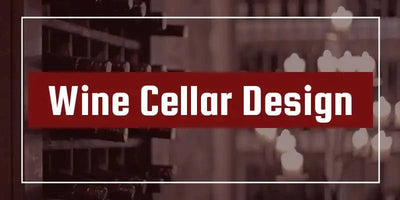
Designing or Upgrading a Wine Cellar?
We got you! Here at Wine Coolers Empire, we will guide you in building your dream wine cellar.



